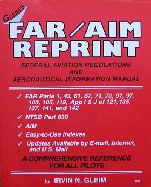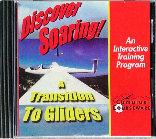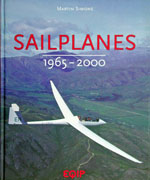
FAR/AIM Reprint - Gleim, ASA, and others
Miscellaneous
 FAR/AIM Reprint - Gleim, ASA, and others |
Federal Aviation Regulations (FARs) change all the time and you must keep up to date. Although the Aeronautical Information Manual (AIM) covers a lot of ground on instrument procedures and airport markers and the like, there's much there for the glider pilot as well. This book used to be on my must have list but if you connect to the internet via broadband or DSL, there's little point. It's all online at Aeronautical Information Manual (AIM), FAR part 61 (pilot certification), FAR part 91 (general operating and flight rules). After the 11 Sep 01 terrorist attacks, pilots were advised to review their intercept procedures. This is where you'll find that - as well as a wealth of other info. Things like: airspace (class A, B, C, D, E, and G - restricted areas and other SUA [Special Use Airspace]), radio communication procedures, meteorology, potential flight hazards, and much more. Available at most pilot shops. |
 A Transition To Glider -
Cumulus Courseware A Transition To Glider -
Cumulus Courseware |
"Discover Soaring - A transition To
Gliders" is an interactive CD-ROM course, designed to familiarize the
transitioning power pilot with gliders. Although novel in its approach, in my opinion, the project failed. It is with reluctance that I pass
such judgment because much well intentioned work went into creating this
production. The photography is amateurish, with little or no attention paid to lighting. Many of the scenes are quite dark as shown by this screen shot demonstrating a stall - right. Or, how about learning about how to preflight the day's activities - note the shadow. I understand that the course developers used the VHS tape of the same name for their video source... but really. The narration is better. The narrative content is not in depth, which is expected from an introductory overview, but adequately touches on the high points of what it takes to be a glider guider. The software is Neanderthal. The graphic output is not contained within a standard window but is just blasted out to the screen (see the full screen shot ). You can't background or move or resize the display and, if the display hides a desktop shortcut, too bad. You can't get to it. The user interface is poor. There's a short test at the end of each section but it's impossible to skip past it, should you want to. There are no user selectable options at all, so you can't even turn off that annoying music that plays when you select a test answer. There's an alphabetical index so that you can randomly select a topic. I found out (much) later that the index contents only go up to the letter "C". You have no real way of knowing that and yet you are given the option of clicking on tabs A - Z. If you click past "C", the request is ignored - no error message, no nothing. On this shot I'm clicking on the index "H"s - hmmmm. ... the list goes on. The VHS tape by the same name is also available. |
 Sailplanes 1965 - 2000 - Martin Simons |
A beautiful book, recently hard to find, but now available again from the publisher. High quality paper and pictures (click for sample). A description of just about any production glider imaginable, organized by country of manufacture. Published by EQIP Werbung & Verlag GmbH, Köningswinter, Germany (http://www.eqip.de/) |